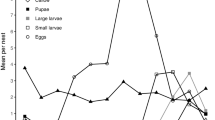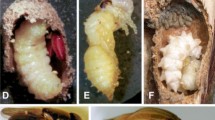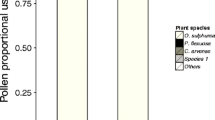Summary
On Dartmoor, UK the temperate halictine beeLasioglossum (Evylaeus) fratellum is solitary and univoltine. A significant proportion of individually marked foundresses reproduce during two different seasons (iteroparity). This could represent a form of risk-spreading in environments where conditions are harsh and unpredictable. Perhaps associated with iteroparity, foundresses put in relatively low reproductive effort, often failing to provision their nests on suitable days, despite the small number of days available on Dartmoor. Foundresses stopped provisioning asynchronously, then remained in their nests until well after offspring emergence. There was a small proportion of digynous nests, in which nest-sharing appeared to be temporary.L. (E.) calceatum had a similar life-cycle on Dartmoor.L. villosulum was also solitary, and was able to provision its nests under less favourable weather conditions than the other two species. Information is also provided on nest productivity andSphecodes parasites.
Similar content being viewed by others
References
Batra, S. W. T., 1990. Bionomics ofEvylaeus comagenensis (Knerer and Atwood), a facultatively polygynous, univoltine, boreal halictine bee.Proc. Entomol. Soc. Wash. 92:725–731.
Heide, A. von der, 1992. Zur Bionomie vonLasioglossum (Evylaeus) fratellum (Perez), einer Furchenbiene mit ungewöhnlich langlebigen Weibchen (Hymenoptera, Halictinae).Drosera 1992:171–188.
Horn, H. S., 1978. Optimal tactics of reproduction and life-history. In:Behavioural Ecology, an evolutionary approach (J. R. Krebs and N. B. Davies, Eds.), Blackwell Scientific Publications, Oxford, pp. 411–429.
Iwata, K. and S. F. Sakagami, 1966. Gigantism and dwarfism in bee eggs in relation to the modes of life, with notes on the number of ovarioles.Jap. J. Ecol. 16:4–16.
Kaitala, V., Smith, B. H. and W. M. Getz, 1990. Nesting strategies of primitively eusocial bees: a model of nest usurpation during the solitary state of the nesting cycle.J. theor. Biol. 144:445–471.
Michener, C. D., 1990. Castes in xylocopine bees. In:Social Insects (W. Engels, Ed.). Springer Verlag, Berlin, pp. 123–146.
Minckley, R. L., W. T. Wcislo, D. Yanega and S. L. Buchmann, 1994. Behaviour and phenology of a specialist bee (Dieunomia) and sunflower (Helianthus) pollen availability.Ecology 75:1406–1419.
Nature in Cambridgeshire, 1976–1991. Cambridge, U.K.
Packer, L., 1990. Solitary and eusocial nests in a populaton ofAugochlorella striata (Provancher) (Hymenoptera; Halictidae) at the northern edge of its range.Behav. Ecol. Sociobiol. 27:339–344.
Packer, L., 1991. The evolution of social behaviour and nest architecture in sweat bees of the subgenusEvylaeus (Hymenoptera: Halictidae): a phylogenetic approach.Behav. Ecol. Sociobiol. 29:153–160.
Packer, L., 1992. The social organization ofLasioglossum (Dialictus) laevissimum (Smith) in southern Alberta.Can. J. Zool. 70:1767–1774.
Packer, L., 1993. Multiple-foundress associations in sweet bees. In:Queen number and sociality in insects (L. Keller, Ed.). Oxford University Press, pp. 215–233.
Packer, L. and G. Knerer, 1985. Social evolution and its correlates in bees of the subgenusEvylaeus (Hymenoptera; Halictidae).Behav. Ecol. Sociobiol. 17:143–149.
Packer, L. and G. Knerer, 1986. An analysis of variation in the nest architecture ofHalictus ligatus in Ontario.Ins. Soc. 33:190–205.
Packer, L., V. Jessome, C. Lockerbie and B. Sampson, 1989a. The phenology and social biology of four sweet bees in a marginal environment: Cape Breton Island.Can. J. Zool. 67:2871–2877.
Packer, L., B. Sampson, C. Lockerbie and V. Jessome, 1989b. Nest architecture and brood mortality in four species of sweat bee (Hymenoptera; Halictidae) from Cape Breton Island.Can. J. Zool. 67:2864–2870.
Plateaux-Quenu, C., 1959. Un nouveau type de societé d'insects.Halictus marginatus Brulle.Ann. Biol. 35:235–444.
Plateaux-Quenu, C., 1992. Comparative biological data on two closely related eusocial species:Evylaeus calceatus (Scop.) andEvylaeus albipes (F.) (Hym., Halictinae).Ins. Soc. 39:351–364.
Reeve, H. K. and F. L. W. Ratnieks, 1993. Queen-queen conflicts in polygynous societies: mutual tolerance and reproductive skew. In:Queen number and sociality in insects (L. Keller, Ed.), Oxford University Press, New York. pp. 45–85.
Sakagami, S. F. and H. Fukuda, 1972. Life of a Japanese eusocial halictine bee,Lasioglossum duplex, out of brood rearing season (Hymenoptera, Halictidae).Ins. Soc. 19:137–152.
Sakagami, S. F. and M. Munakata, 1972. Distribution and bionomics of a transpalaearctic eusocial halictine bee,Lasioglossum (Evylaeus) calceatum, in northern Japan, with reference to its solitary life cycle at high altitude. Jour. Fac. Sci. Hokkaido Univ. Ser. VI, Zool.18:411–439.
Sakagami, S. F. and Y. Maeta, 1977. Some presumably presocial habits ofCeratina bees, with notes on various social types in Hymenoptera.Ins. Soc. 24:319–343.
Seger, J. and H. J. Brockmann, 1987. What is bet-hedging? In:Oxford Surveys of Evolutionary Biology (P. Harvey and L. Partridge, Eds.), Oxford University Press, Oxford. pp. 182–211.
Svensson, B. G., A. W. Ebmer and S. F. Sakagami, 1977.Lasioglossum (Evylaeus) boreale, a new Halictinae (Hymenoptera, Apoidea) species found in northern Sweden and in Hokkaido, Japan, with notes on its biology.Ent. scand. 8:219–229.
Vehrencamp. S. L., 1983. A model for the evolution of despotic versus egalitarian societies.Anim. Behav. 31:667–682.
Author information
Authors and Affiliations
Rights and permissions
About this article
Cite this article
Field, J. Patterns of provisioning and iteroparity in a solitary halictine bee,Lasioglossum (Evylaeus) fratellum (Perez), with notes onL. (E.) calceatum (Scop.) andL. (E.) villosulum (K.). Ins. Soc 43, 167–182 (1996). https://doi.org/10.1007/BF01242568
Received:
Revised:
Accepted:
Issue Date:
DOI: https://doi.org/10.1007/BF01242568




